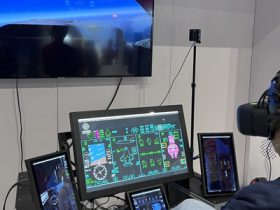A second phase of Replicator—the Pentagon’s year-old, high-profile effort to buy thousands of cheap-ish autonomous weapons—aims to procure defenses against small drones.
Dubbed Replicator 2, the effort will focus on the threat to installations and “force concentrations,” according to a Sept. 27 memo from Defense Secretary Lloyd Austin. The memo, released on Monday, says the Pentagon will ask for money for the effort in the fiscal 2026 budget request now under construction and that deliveries will be expected within 24 months of the budget’s passage.
The memo directs Deputy Defense Secretary Kathleen Hicks and Vice Chairman of the Joint Chiefs of Staff Adm. Christopher Grady, “working with Component heads through the Deputy’s Innovation Steering Group,” to “oversee the development of a Replicator 2 plan.” Its execution will be led by the Defense Innovation Unit, working with the defense undersecretary for acquisition and sustainment, the Pentagon’s point person on counter-UAS systems. The service branches will handle development, production, and fielding of systems.
The setup mimics the first Replicator effort, whose initial contracts were awarded earlier this year, one Defense Department official told Defense One.
“Most of the work that’s already being done has been headed up by the Army and the Marine Corps,” the official said. “Where [the Deputy Defense Secretary and Vice Chairman of the Joint Chiefs of Staff] are going to be able to help is bring some of the department’s capabilities to bear in terms of scaling things up, clearing up some policy issues and authorities issues, especially when it comes to counter-UAS in the United States.”
The official added, “We can cut red tape and make things move.”
A number of offices already pursue anti-drone work, such as the Army-led Joint Counter-small Unmanned Aircraft Systems Office and the Marine Corps’ Capabilities Development Directorate.
And Austin has made counter-drone defenses a special focus, launching a counter-UAS working group in March.
U.S. forces regularly fight off drones in the Middle East. The Army faces drone attacks against its bases there; in February, three Americans were killed and more than 40 wounded by drones in Jordan. The Navy, meanwhile, frequently shoots down drones launched from Yemen.
Some of the most powerful drones faced by U.S. forces are variants of Iran’s Shahed-136, a large one-way attack drone that can fly at 114 miles per hour and carry 110 pounds of explosives.
Such drones are less powerful than cruise and ballistic missiles, which carry hundreds of pounds of explosives or more and fly hundreds of miles an hour. However, with comparable ranges of over 600 miles, the Shahed and its ilk offer U.S. adversaries a way to hit far-off targets on the cheap: a single Shahed can cost under $50,000, a fraction of the multi-million-dollar price of a cruise missile.
The Army has said that a layered approach of multiple weapons and sensors is necessary for taking down drones. It has also praised the performance of Raytheon’s Coyote counter-drone system, which uses loitering munitions to take out incoming loitering munitions.
In its recent unfunded-priorities list, the Army said a $185 million purchase of Coyote anti-drone systems was an item that just barely missed being included in the 2024 budget request. At $125,000 per system, prices will need to come down to match the cost of the Shahed-like drones attacking U.S. forces.
One possible option is Ukrainian forces’ use of cheap sensors and machine guns. While effective, this low-budget approach allows enemy drones to get so close that friendly forces can get showered with debris.
Alternative methods include electronic warfare or even capturing drones, via nets. Both systems have been tried in Ukraine.
But if Replicator 2 is aimed at fending off the kind of drones that have threatened U.S. forces in the Middle East, the effort is unlikely to focus on one of the dominant scourges of the Ukrainian battlefield: first-person-view loitering munitions.
FPVs are less relevant in the Middle East where U.S. bases are generally hardened, an officer in the 10th Mountain Division, which handles counter-drone operations in Iraq, previously told Defense One.
Tools to deal with these threats, by contrast, are typically more affordable than solutions needed for large loitering munitions like Shaheds. Systems used against FPVs and quadcopters include backpack-portable jammers, wearable drone detectors, and even shotguns.
Replicator 1 update
The memo also said the first stage of Replicator, which focused on fielding cost-effective drones, is “on track” to hit a goal of fielding systems by next summer.
The department said AeroEnvironment’s Switchblade 600 loitering munition system was part of the program, but did not identify others. The Switchblade 600 costs “less than a Javelin anti-tank weapon,” a company representative said, which costs around $80,000.
Many observers of the Defense Department have hailed the Replicator effort as a way to break the Pentagon’s general practice of buying complicated, expensive weapons. Deputy Defense Secretary Kathleen Hicks has sought to show the importance of Replicator not just for acquiring new, cheaper, faster-to-build drone tech but reforming the way the Pentagon does all of its building and buying.
Patrick Tucker contributed to this post.
Read the full article here








Leave a Reply